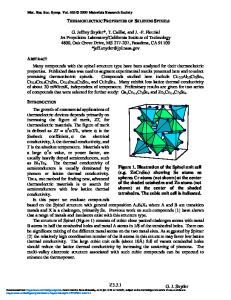On the Thermoelectric Properties of Layered Cobaltates
- PDF / 625,799 Bytes
- 12 Pages / 612 x 792 pts (letter) Page_size
- 25 Downloads / 284 Views
0886-F01-05.1
On the Thermoelectric Properties of Layered Cobaltates Qiang Li Condensed Matter Physics and Materials Science Department, Brookhaven National Laboratory Upton, NY 11973-5000, U.S.A. ABSTRACT A study on the thermoelectric properties of layered cobaltates is presented, based on the dynamic mean field theory for strongly correlated electron systems. Electron correlation results in a crossover from coherent quasi-particle excitation at low temperature to incoherent excitation at high temperatures in cobaltates. With an extremely narrow quasi-particle bandwidth (hωc ~ 50 meV), the thermal destruction of Fermi-liquid occurs at the moderate crossover temperature TM (~ 200 K), and suggests a new scaling for thermoelectric power S of cobaltates (S ~ kT/hωc ~ T/TM ) at low temperatures. At high temperatures, the dominating incoherent excitation leads to a weak temperature dependent S, and electric resistivity ρ approaches the Mott-limit ha/e2 ~ a few mΩ⋅cm for cobaltates, where a is a lattice constant. INTRONDUCTION One of the byproducts from the extensive research in high temperature superconductivity (HTS) is the layered cobaltates (AxCoOy). In 1997, I. Terasaki and coworkers reported high thermoelectric power (~ 100 µV/K at room temperature) in sodium cobaltates (Na0.5CoO2) showing metallic behavior.1 This observation was made during the investigation of new materials as a reference to HTS cuprates. For many years now, cobaltates have been pursued for their potential application as a thermoelectric material. In the field of basic science research, cobaltates are generating a great deal of interests as well. There are several reasons for the physics community to get excited. First, cobaltates provide another class of transition metal oxides that can be used for exploring the metal-insulator transition,2 a phenomenon that is at the heart of the strongly correlated electron systems. It is widely believed that the metal-insulator transition plays a vital role in the correlated electron systems that display a broad range of interesting phenomena, including the colossal magnetoresistance (CMR) in manganites and high temperature superconductivity in cuprates. Secondly, unlike cuprates, cobaltates appeared to have a simpler spectral function, which determines the nature of charge transport.2 It is perhaps less difficult to compare the experimental results with the theoretical predictions of the manybody physics in already complicated systems like transition metal oxides. In contrast, HTS cuprates have multiple bands crossing the Fermi energy EF, gaps at EF, and spectral lineshapes that differ sharply in different areas of the Brillouin zone.3 The last, but not the least, is the discovery of superconductivity in water interacted sodium-cobaltates: Na0.35CoO2 · 1.3H2O.4 The pairing nature in hydrated cobaltates might provide valuable insight to the superconducting mechanism of doped Mott systems.5 However, the emphasis of this articles is placed on the investigation of thermoelectric properties of cobaltates. The ear
Data Loading...









